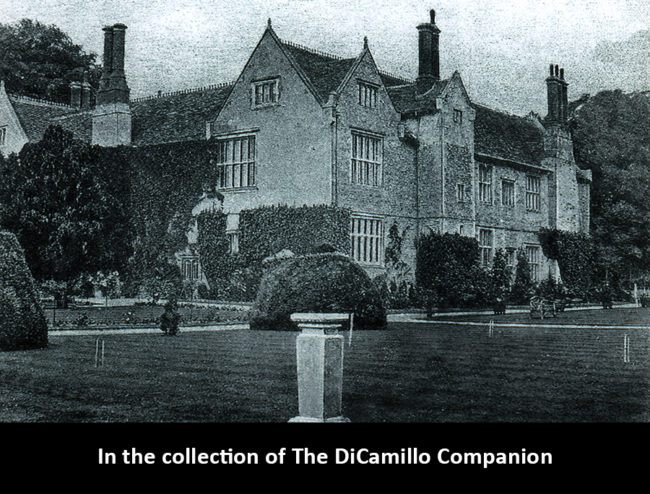
The House from a circa 1905 postcard
Earlier Houses: An earlier house was burned by supporters of Lady Jane Grey in 1553 after Mary Tudor slept here. The remains of the earlier medieval manor house were incorporated into the current 16th century house.
House & Family History: In 1553 Mary Tudor, fleeing imprisonment by the Duke of Northumberland, spent a night at the medieval Sawston Hall. Northumberland's soldiers followed Mary to Sawston, forcing her to flee the next morning disguised as a dairymaid. As she fled, the soldiers set fire to the medieval manor, destroying a large part of the House. Legend has it that Mary promised to help rebuild Sawston as a sign of gratitude for the protection given her by the Huddleston family; what is known is that, as queen, Mary granted the use of stone from Cambridge Castle for rebuilding Sawston Hall, something that occurred between 1557 and 1584. It's because of this unusual use of stone that Sawston is the only Elizabethan house in the Cambridgeshire made of stone. Sawston Hall is historically significant due to its continuous Catholic ownership; for centuries Sawston was the only place near Cambridge where Mass was celebrated. The House features a number of priest holes, the most spectacular being the one at the top of the spiral staircase, one of the finest in England. The Great Hall has fine Elizabethan paneling and a fireplace with a fireback dated 1571. During World War II Sawston was occupied by the U.S. Air Force, who used the House as an operations base (the air raid shelter built by the American military remains in the grounds). In 1982 the Huddleston family sold the Sawston Estate, after which the House became a language school, a purpose it served until the early 21st century. In 2004 Sawston was sold and returned to use as a private residence (the Estate was listed for sale in March 2001 and again, in "Country Life," July 4, 2002, for £3.4 million).
Collections: An early 16th century English chasuble, once at Sawston, where it was probably used in the celebration of the Mass, is today in the collection of the Fitzwilliam Museum, Cambridge.
Garden & Outbuildings: The House is surrounded by almost 60 acres of grounds, which includes a Site of Special Scientific Interest protected by Natural England because of the presence of Cambridge Milk Parsley, a rare English native plant.
Chapel & Church: Sawston Hall sits adjacent to the Norman St. Mary's Church. The Catholic chapel at back of House dates largely from the 1820s and features fine paneling and an 18th century decorated plaster ceiling.
John Bernard (J.B.) Burke, published under the title of A Visitation of the Seats and Arms of the Noblemen and Gentlemen of Great Britain and Ireland, among other titles: 2.S. Vol. II, p. 139, 1855.
Country Life: CXV, 1902, 1998, 2092, 1954.
Title: Treasures of the Fitzwilliam Museum - 1993
Author: Smith, Ruth (Editor)
Year Published: 1993
Reference: pg. 131
Publisher: London: The Pevensey Press
ISBN: 0907115144
Book Type: Softback
Title: Country Life (magazine)
Author: NA
Year Published: NA
Reference: Jul 4, 2002
Publisher: London: Future plc
ISBN: NA
Book Type: Magazine
Title: Burke's & Savills Guide to Country Houses, Volume III: East Anglia
Author: Kenworthy-Browne, John; Reid, Peter; Sayer, Michael; Watkin, David
Year Published: 1981
Publisher: London: Burke's Peerage
ISBN: 0850110351
Book Type: Hardback
House Listed: Grade I
Park Listed: Grade II
Current Seat / Home of: Major A.C. Eyre; here since 2004.
Past Seat / Home of: Sir John Hodleston (Huddlestone or Huddleston), mid-16th century; Huddleston family here from 1517 until 1982. Nicholas Owen, circa 1600.
Current Ownership Type: Individual / Family Trust
Primary Current Ownership Use: Private Home
House Open to Public: No
Historic Houses Member: No